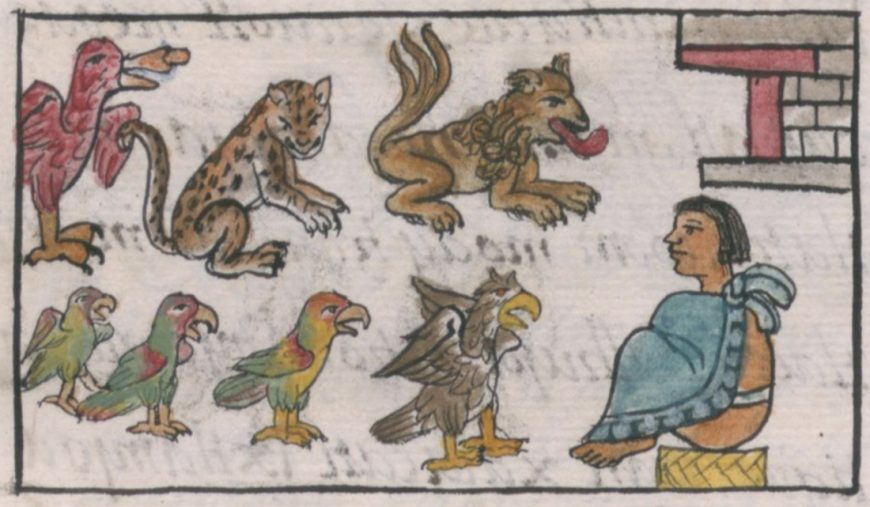Speakers: Dr. Lauren Kilroy-Ewbank and Dr. Beth Harris
[0:00] [music]
Dr. Lauren Kilroy-Ewbank: [0:05] We’re here at the Templo Mayor, the main temple of the Azetcs, which is in present-day Mexico City. This was the heart, the most sacred place in the Aztec empire. But they didn’t call themselves Aztecs.
Dr. Beth Harris: [0:19] They called themselves the Mexica or, more accurately, the Tenochca Mexica.
Dr. Kilroy-Ewbank: [0:24] They called the city Tenochtitlan.
Dr. Harris: [0:26] That basically means “the place of the prickly pear cactus.” The name Aztec is something that was given to them later in the 19th century. The Mexica, or the Aztec, belonged to a much larger ethnic group called the Nahua, who spoke Nahuatl.
Dr. Kilroy-Ewbank: [0:41] They founded their capital city here because of a vision that they saw at the end of a very long period of traveling.
Dr. Harris: [0:49] One of the most important myths for the Aztecs was this migration myth, where they left their mythic homeland of Aztlán from a place called Chicomoztoc, or The Place of the Seven Caves. The ancestors begin this migration because their patron deity, Huitzilopochtli, told them to go on this migration, and to behold the sign, and to establish a city there.
Dr. Kilroy-Ewbank: [1:13] The sign that they saw at the end of their journey was an eagle perched on a cactus that was growing out of a rock.
Dr. Harris: [1:19] In the middle of a lake. That lake is here in Central Mexico. In fact, modern-day Mexico City is on top of that lake.
Dr. Kilroy-Ewbank: [1:27] The city of Tenochtitlan is founded in 1325. The city is a planned city. The Spanish who conquered it two centuries later were awed by the incredible planning. They saw canals. They saw four major causeways going through the city, meeting at the center point of this temple where we are now.
Dr. Harris: [1:47] The city was all laid out on a very careful grid plan. This was a very ordered, very clean, urban center.
Dr. Kilroy-Ewbank: [1:54] It had four quadrants, and this was part of Aztec ideology.
Dr. Harris: [1:58] They believed that the universe was divided into four, and so what the city reflects is this cosmological diagram, with Tenochtitlan as the center of the universe and their main temple, the Templo Mayor, in the sacred precinct as the center of that center.
Dr. Kilroy-Ewbank: [2:14] We’re talking about the center of a vast empire, with subordinate cities that pay tribute to the Aztecs.
Dr. Harris: [2:22] Some of the goods that made up this tribute included lots of luxury and precious goods, like feathers, or greenstone, or textiles.
Dr. Kilroy-Ewbank: [2:31] It was critical for the Aztecs to bring prisoners from those subordinated cities here to Tenochtitlan to be part of a sacrificial ritual.
Dr. Harris: [2:41] Maybe some of you are familiar with what’s called the flowery wars, which was a form of ritualized warfare, or battles, where the main point was to acquire captives for the purpose of sacrifice.
[2:54] Initially, they didn’t have this vast power over the Valley of Mexico. They were subordinate to some other places around the lake, who they eventually defeated. They formed what’s called the Triple Alliance: Tenochtitlan, Texcoco, and Tlacopan. Eventually, the peoples of Tenochtitlan became more powerful.
Dr. Kilroy-Ewbank: [3:17] We’re talking about a city that, at its height, had between 200 and 300 thousand people, estimated.
Dr. Harris: [3:23] It was such a large population, it was critical to find ways to feed the people that lived here. There were important agricultural techniques used, like chinampas, these muddy raised beds, to help provide food for the people of Tenochtitlan.
[3:39] The landscape played a critically important role also in ritual. We know that there were many processions made to various mountains around the lake.
Dr. Kilroy-Ewbank: [3:48] It’s hard to imagine, as we look over Mexico City today, that this was once a lake.
Dr. Harris: [3:53] It’s after the Spanish conquest in 1521 that you begin to have the draining of the lake. Of course, it’s still a lake bed, so you can actually see the parts of Mexico City that are sinking.
Dr. Kilroy-Ewbank: [4:04] One of the largest cities of the Mesoamerican world in the 15th century is one of the largest cities today in the 21st century, Mexico City.
[4:12] [music]
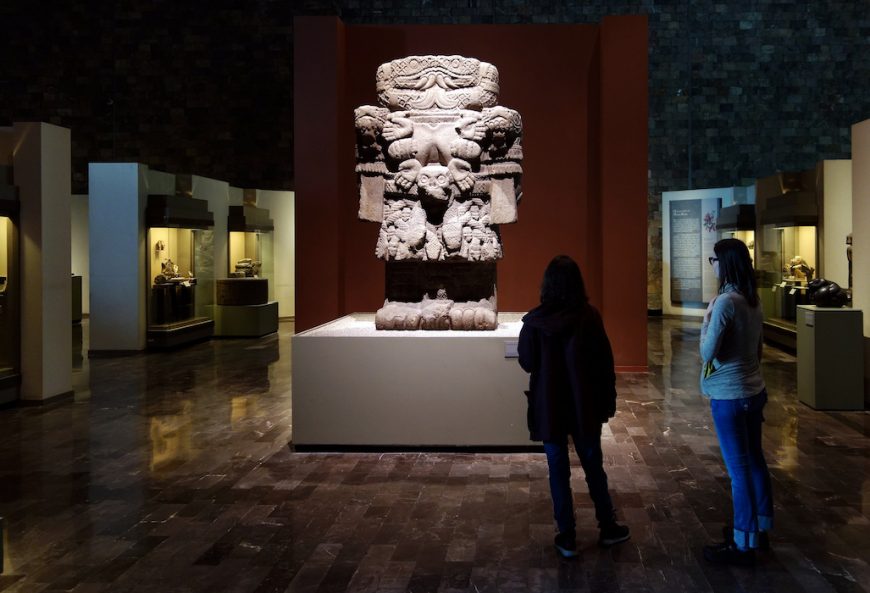
Coatlicue, c. 1500, Mexica (Aztec), found on the Southeast edge of the Plaza Mayor/Zocalo in Mexico City, basalt, 257 cm high (National Museum of Anthropology, Mexico City) (Smarthistory video and essay on this Coatlicue sculpture)
If you travel to Mexico City today, chances are you might visit museums such as the Templo Mayor Museum in the heart of the city or the National Museum of Anthropology in Chapultepec Park. Either is sure to dazzle you with an impressive array of exquisitely crafted objects (that we typically label as “artworks”), ranging from monumental stone sculptures and shell mosaics to colorfully painted ceramics and figurines. At both museums, Aztec art is the centerpiece: excavations at the Aztec Templo Mayor fill the onsite museum, and Aztec art similarly occupies the central galleries within the Anthropology museum. The Aztecs were only one group that made up the diverse indigenous peoples of Mesoamerica, but they were among those groups that encountered Europeans when they arrived in the Americas. Collections like those at the Templo Mayor museum or National Museum of Anthropology attest to the skill and creativity of Aztec artists.
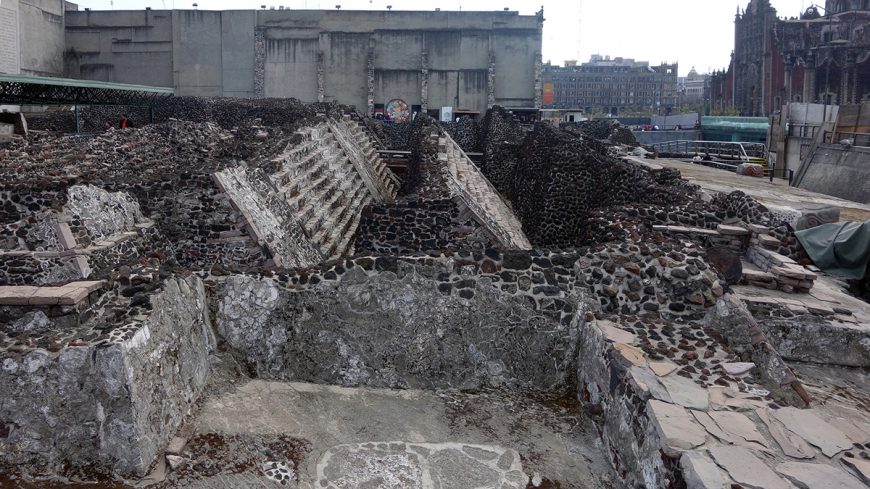
Ruins of the Templo Mayor, 1375-1520, Tenochtitlan, (Museo del Templo Mayor, Mexico City) (photo: Dr. Steven Zucker) (Smarthistory video on the Templo Mayor)
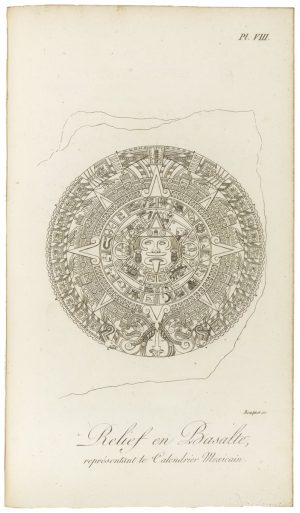
Alexander von Humboldt,”Basalt Relief representing the Mexican Calendar,” plate VIII from Vues des Cordillères et monumens des peuples indigènes de l’Amérique, 1814-40 (Paris: G. Dufour) (Bibliothèque nationale de France)
What’s in a name?
The German explorer and scientist Alexander von Humboldt arrived in Mexico in 1803 after traveling throughout parts of Latin America. Impressed by what he experienced and saw in Mexico City, he became interested in the country’s indigenous past (the country was then still New Spain). He wrote about the Aztecs and created illustrations of their sculptures. In 1810, he used the name “Aztecs” to describe the powerful Mesoamerican people who had built a vast empire in Mexico and who encountered the Spaniards in 1519. He adapted the name Aztec from the Nahua word Aztlan, which referred to their mythical homeland. Several decades later, the historian William H. Prescott popularized the term, and it is still common today.
But what did the Aztecs call themselves? They referred to themselves as the Mexica. Those who lived in their capital city, Tenochtitlan, were the Tenochca-Mexica. The Mexica formed part of a larger ethnic group known as the Nahua, who spoke Nahuatl. Unfamiliar with this language? You might know a few words: chocolate, chipotle, coyote, tomato, and avocado derive from Nahuatl words. Even the name Mexico, adopted after Mexicans gained independence from Spain in 1821, comes from Mexica.
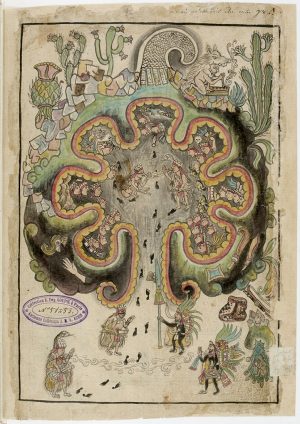
Chicomoztoc, illustration from Historia Tolteca-Chichimeca, 16th century, folio 29 (Bibliothèque nationale de France)
Where did the Mexica come from?
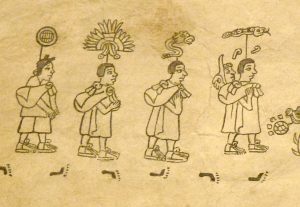
Huitzilopochtli carried on the back of a person, Boturini Codex, c. 1530-41, detail of folio 4 (Museo Nacional de Antropología, Mexico City)
Several myths describe the migration of the Mexica from Aztlan, thought to be somewhere in northern Mexico or the southwestern United States. The Mexica departed Chicomoztoc at the urging of their patron deity, Huitzilopochtli, to journey to establish a new settlement.
Early colonial codices (books), like the Codex Boturini, show this migration, with footprints indicating the direction the ancestors walked on their journey. In this particular codex, we even see Huitzilopochtli carried on the back of one of the individuals migrating, alluding to his role in the migration.
Huitzilopochtli told the Mexica to look for a sign—an eagle on a cactus—that would tell them where to settle. Their migration led them to the Valley of Mexico. They were generally disliked by other groups who found the Mexica uncivilized or unrefined, largely because they were foreigners who worked initially as mercenaries for other people living around Lake Texcoco.

The flag of Mexico with an eagle perched atop a cactus (source: Alex Covarrubias, CC0)
According to Mexica mytho-historical textual sources (written down in the early colonial period), they finally witnessed the sign on an island in the middle of Lake Texcoco in the year 1325. It was there that they established Tenochtitlan, their capital city. They connected the city to the mainland with causeways to make coming and going to the city more efficient. If you look at the Mexican flag today, you will see a reference to this origin story. In the center of the flag an eagle is represented on a cactus, and the eagle stands on a glyph for stone and water.
Forging an empire
As they developed their city and gained more prominence in the Valley of Mexico, the Mexica formed an alliance with Texcoco (Tetzcoco) and Tlacopan (today, Tacuba), known as the Triple Alliance. Really, when we refer to the “Aztecs,” we are talking about the people who formed this alliance.
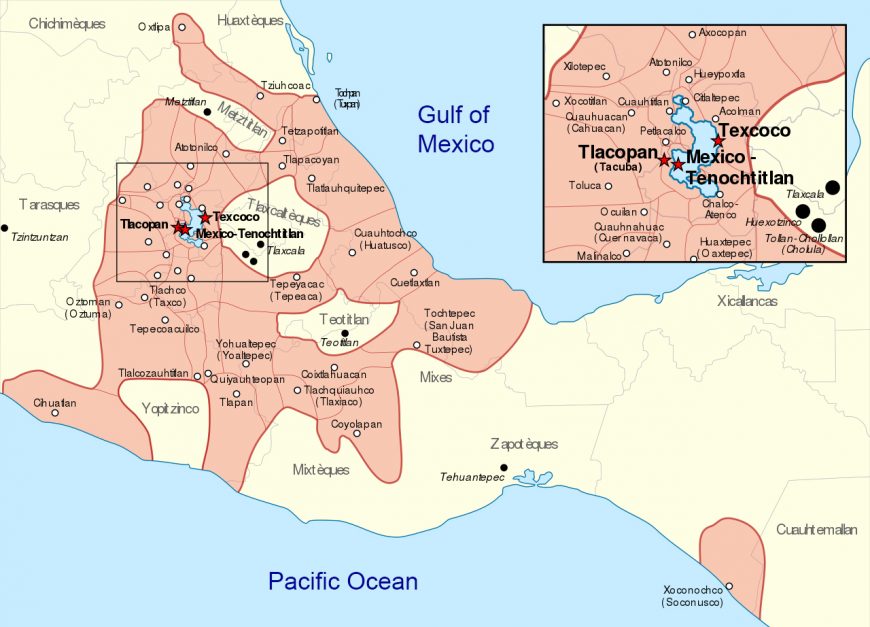
Map of the Aztec Empire under the Triple Alliance, 1519 (source: Yavidaxiu, CC BY-SA 3.0)
War was common in the Aztec empire. There were two main types of wars: one was primarily for conquest and expansion of the empire, while the other involved a more ritualized form of battle, called “flowery wars.” The flowery wars may have served several functions, including training soldiers, capturing individuals for sacrifice, or weakening enemies.
The Triple Alliance had a large and powerful military that conquered many peoples throughout Mesoamerica. Tribute was gathered from those the Alliance controlled, and we can see a record of this in the mid-sixteenth-century Codex Mendoza. Tribute lists show what items, like bird feathers, greenstone or jade, and textiles, that peoples controlled by the Mexica sent back to Tenochtitlan.
Uprisings against Aztec control were common, meaning that armed conflicts occurred with regularity. Many of these conquered peoples, or even those who successfully managed to maintain independence but still disliked the Aztecs, joined with Hernan Cortés’s army when he journeyed towards Tenochtitlan in 1519.
Mexica rulers
The Mexica ruler was known as the huey tlatoani (“chief speaker”; pronunciation: whey-tla-toe-anee). There were eleven tlatoque (the plural form of tlatoani) of Tenochtitlan, beginning with Acamapichtli in 1375 and ending with Cuauhtemoc in 1525. The huey tlatoani was tasked with maintaining the city, participating in important rituals, and overseeing the military. They lived in large, sumptuous palaces. Moteuczoma II Xocoyotzin’s palace had rooms for living quarters, meetings, and storage, but also had gardens, a zoo, and even an aviary. The colonial Florentine Codex describes the zoo as having “ocelots, bears, mountain lions, and mountain cats… eagles… and various birds.” The royal palaces bordered the most important location in the capital—the sacred precinct—which was thought to symbolize the navel of the universe, or axis mundi.
Sustaining an empire
Tenochtitlan was a bustling city, with more than 100,000 people living in it. Food and water were of great concern, especially because the city was located on an island in a lake. Chinampas, or floating gardens, provided the food necessary to sustain the Aztec empire. They consisted of human-made islands where crops could be grown. Food staples included maize, squash, and beans. Some chinampas were even used to grow flowers exclusively. If you visit Xochimilco today, you can get a sense of what chinampas look like, with people still navigating canals amidst floating gardens.
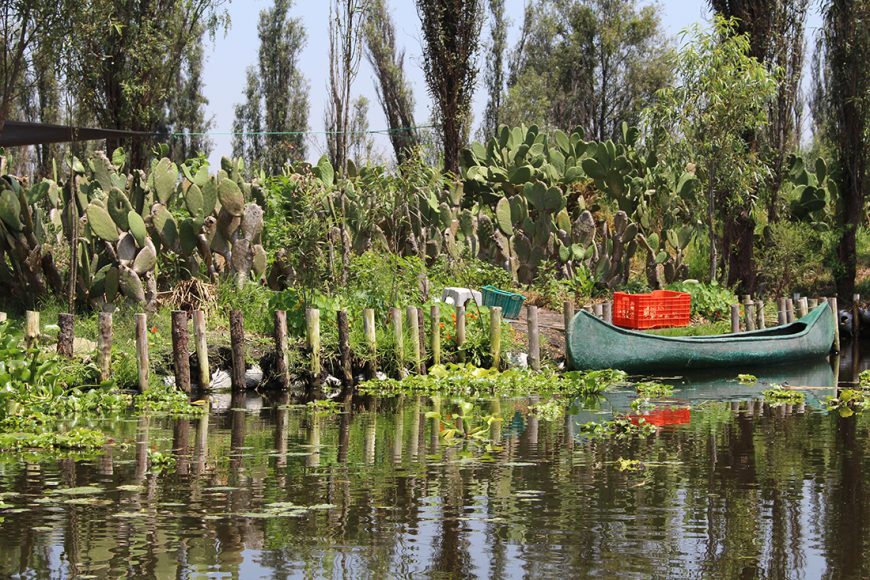
Traditional floating gardens (chinampas) in Xochimilco, Mexico City today (photo: Px-lga, CC BY-SA 4.0)
Large aqueducts brought fresh water to the capital. These massive engineering projects were supported by the huey tlatoani because they were critical to the survival of his people.
A complex pantheon of deities
The Mexica had numerous deities in their religious pantheon. The two most important deities were Huitzilopochtli and Tlaloc, a rain and agricultural god. Their significance was symbolized by the twin temples atop the Templo Mayor in the center of Tenochtitlan.
Placed within the heart of the sacred precinct, the Templo Mayor was the largest and most important temple in the empire. One side symbolized Tlaloc, and included objects, symbols, and colors (like blue-green) associated with the rain god. The other side symbolized Huitzilopochtli, and similarly used a variety of means to convey his warrior and solar associations. Together, Tlaloc and Huitzilopochtli communicated the Mexica focus on warfare. Fire and water, known in Nahuatl as atl-tlachinolli (“burnt water”; pronunciation: at-ul tlach-ee-no-lee), symbolized war, which was essential to the expansion of the Mexica empire.
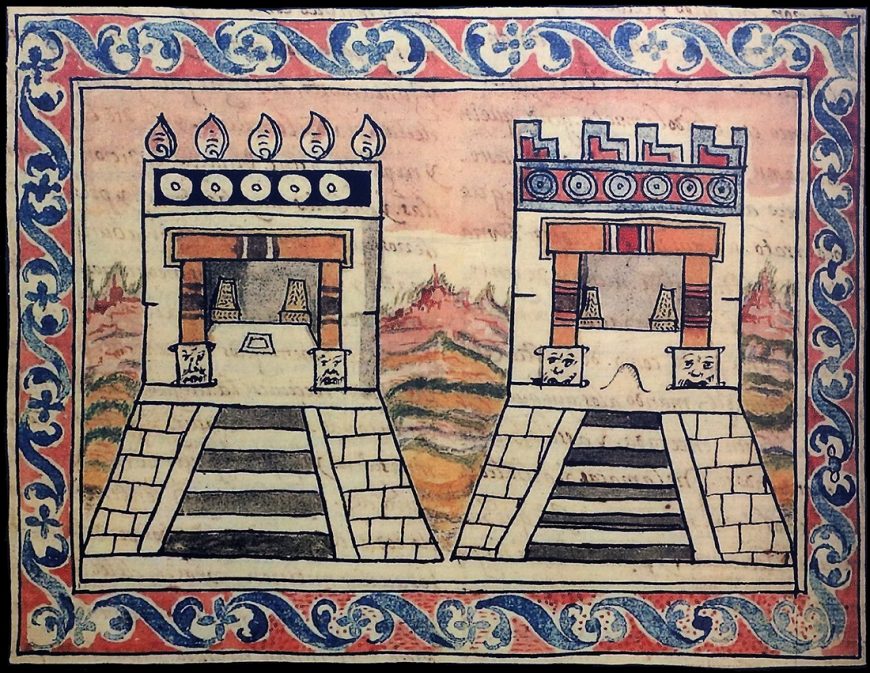
Diego Durán, illustration of the Templo Mayor with the twin temples of Tlaloc (left) and Huitzilopochtli (right), from The History of the Indies of New Spain, 1579 (Biblioteca Nacional, Madrid)
Other important deities included:
- Tezcatlipoca (“Smoking Mirror”), patron of rulers. He is also associated with sorcery, symbolized by the obsidian mirror that he wears
- Quetzalcoatl (“Feathered Serpent”), a god with a long history in Mesoamerica. He was associated with the planet Venus, with wind, and also with fertility
- Chalchiuhtlicue (“She of the Jade Skirt”) a goddess of water fertility, and associated with Tlaloc. While Tlaloc presided over rain, she was associated with bodies of water like lakes and rivers
- Chicomecoatl (“Seven Serpent”) and Cinteotl (“Maize God”), both associated with maize and sustenance
- Mictlancihuatl (“Lady of Mictlan”) and Mictlantecuhtli (“Lord of Mictlan”), deities of death and who presided over Mictlan, the underworld
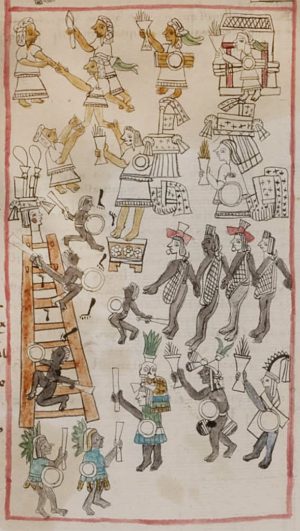
Illustration of Ochpaniztli from Bernardino de Sahagún and indigenous collaborators, Codices matritenses (Primeros Memoriales), 1558-85, f251v (Royal Library, Madrid)
Aztec calendars
The Aztecs had two different calendars: a 260-day ritual calendar called the tonalpohualli (day count), and a 360-day (plus 5 extra days) calendar called the xiuhpohualli (year count). The xiuhpohualli was divided into eighteen months of twenty days each, and each of these months had a festival that honored a specific deity or deities.
These festivals often included music, dancing, offerings, and sacrifice (whether self-sacrifice or human sacrifice). For instance, the eleventh month had the festival of Ochpaniztli (“sweeping of the roads”), which occurred sometime between August to September (or September to October by some accounts), and was intended to celebrate the fall harvest. It honored the earth goddess(es) Tlazolteotl and Toci, and involved sweeping. Sweeping here related literally to cleaning, but also symbolically to fertility, because Tlazolteotl was a goddess associated with filth, but also childbirth. She was a patron of midwives and adulterers.
Aztec art

Olmec mask, c. 1200-400 B.C.E., jadeite, 4 x 3-3/8 x 1-1/4 inches, found in offering 20, buried c. 1470 C.E. at the Aztec Templo Mayor (Museo del Templo Mayor, Mexico City) (photo: Dr. Steven Zucker)
Aztec artists worked in a number of different media, from monumental stone sculptures, terracotta sculptures, and murals to codices, featherworks, and mosaics. Stone sculptures like Coatlicue (top of the page) demonstrate the expertise and skill of stone carvers. The sculpture is over-life size, and is carved from a single stone. The patterning on the serpents that form her skirt replicate actual serpent skin. The combination of naturalistic elements paired with more abstract ones is characteristic of Aztec art in general.
The Aztecs were also interested in the arts of earlier cultures, and would bring objects back to Tenochtitlan where they might be buried as part of offerings. At the Templo Mayor, for instance, we find Olmec masks dating to more than a thousand years earlier that were reburied in ritual offerings at the main Aztec temple. Some Aztec art is intentionally archaizing, or fashioned to look like older “archaic” art like that found at Teotihuacan.
Writing with pictures
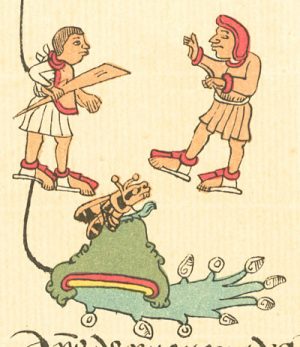
Illustration with the glyph for Chapultepec, Codex Telleriano-Remensis, 16th century, folio 45v (Bibliothèque nationale de France)
Aztecs used picture-writing rather than an alphabetic script like the one you are reading here. A combination of glyphs and images made up this form of writing. For instance, the image of a hill designated a place, and a specific image accompanying the symbol for hill designated the specific place. Chapultepec, for example, would include a hill (tepetl) and a grasshopper (chapolin). A scroll placed in front of someone’s mouth indicated talking or speech (in Nahuatl, this is called tlatolli). The huey tlatoani Motecuzoma Ilhuicamina’s name means “arrow piercing sky,” and his name glyph shows an arrow piercing the sky.
The Spanish conquest
The Aztec empire crumbled after the defeat of Tenochtitlan in 1521. Cortés and his men, along with thousands of indigenous allies who despised the Aztecs, eventually defeated them after cutting off their water supply. People in the capital city fell sick largely because they lacked immunity to European diseases, and their military forces were weakened.
Aztec culture did not disappear, however. Mesoamerican traditions and art continued into what we call the colonial or viceregal era. Even though some forms disappeared, others were transformed, and still others continued unchanged.
Ongoing excavations in and around Mexico City continue to alter our understanding of this diverse and fascinating culture as they reveal more Mexica art and architecture. Recent excavations near the Templo Mayor uncovered the largest Aztec monolith to date, called the Tlaltecuhtli Monolith. It is believed that this monolith may mark the spot of a huey tlatoani’s tomb, and some of the items discovered underneath this monolith are helping us to rewrite what we know about Aztec culture and art.

